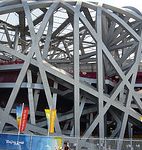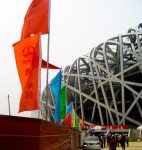There has been much talk in London recently about who got tickets to the 2012 London Olympic & Paralympic Games – and who didn’t. I didn’t apply: athletics leaves me cold. But for someone who has an allergy to most sports, I find myself sucked into that world surprisingly often. A key reason for that is the sports industry increasingly overlaps with the sustainability agenda.
Seven years ago, I met David Stubbs, now head of sustainability at LOCOG (the London Organising Committee for the Games) on the fiftieth floor of a Canary Wharf skyscraper to interview him about the sustainability elements of the proposal they were putting together for the 2012 Games. Then, a few weeks ago, I had a chance for a re-run: Stubbs and his colleague Felicity Hartnett, sustainability partnerships manager, guided me around the site, pointing out key challenges and explaining how they had been tackled.
My first question to Stubbs was how progress to date measures up against the original vision. “When we won the bid,” he replied, “the International Olympic Committee’s environment advisor said to me that, if we achieved even half of what we had promised, it would be way ahead of any previous Games. Well, we are amply past that halfway mark. The point was brought home recently when someone who had been away from the project for a few years visited the Olympic Park and said: ‘It looks like the pictures you showed us back in the beginning!’”
I asked if there had been any big surprises along the way. “Not a surprise, but a pleasant outcome,” Stubbs offered. “And that’s how we have been able to turn round the perception that sustainability costs more. We have found that by making our requirements very clear up front, the market has responded. So we are getting some of our best deals from suppliers who are taking sustainability seriously, and our stance has helped draw in significantly stronger interest from commercial sponsors. This means an effective sustainability approach creates efficiencies, saves costs and helps generate additional revenue.”
Is there anything he wishes he had known at the outset? “If we had known at the time of the bid what we eventually found out in the carbon footprint study,” he admitted, “we would have presented our carbon and energy commitments differently. There has been a lot of knee-jerk criticism about the shortfall in on-site renewable energy generation, compared with our original targets [only around 9% of energy will come from renewable sources rather than the promised 20%]. It would have been far better to have set an overall approach to avoiding carbon emissions, rather than specifying particular technologies to be followed.
“What we have actually achieved through design optimisation, material choices and procurement strategies has resulted in a massive saving of embodied carbon emissions compared with our ‘business as usual reference footprint’. The end result is a much lower-carbon Games than if we had stuck to the letter of the original targets.”
Knowing how polluted the site was, I was interested in how the ground and soils had been cleaned up. The statistics are amazing: nearly two million tonnes of contaminated soil were cleaned for reuse on the Olympic Park in the United Kingdom’s largest ever soil-washing operation. Six “soil hospitals” successfully cleaned most of the one million cubic metres of soil contaminated with oil, petrol, tar, cyanide, arsenic and lead.
And what lessons can other sustainability champions learn? “To be effective, sustainability has to permeate across all departments,” David suggested. “It cannot reside uniquely in a specialist team producing separate policies and glossy reports. There are two particular avenues where you should concentrate your efforts in large projects: procurement, where you need to stamp your authority on what the organisation buys, and how it buys; and, second, workforce training – if you can get sustainability strongly profiled in induction and training modules, you reach the whole organisation.”
As we walked around the site, with major signs calling for “Zero Harm”, Felicity noted that various suppliers had resisted the LOCOG specifications. Told that zero waste was the target, for example, one came back to say that they had got down to just four skips of waste – only to be asked, in effect, “What is it about the zero waste target you don’t understand?”
The sheer scale of the Games has meant dramatically greater supply-chain leverage. “The numbers we deal with are huge,” Felicity noted. “Fourteen million meals to be served, four billion people watching it on TV, 10 million tickets sold. And they are matched by the challenging targets: for example, 100% access via public transport, cycling and walking, zero waste to landfill and sustainably sourced meals.”
So anything that she wishes she had known at the outset? “If I had a crystal ball that told me which of the many opportunities to inspire change was going to have the biggest impact, I could have just focused on that,” she said. “But we didn’t have a crystal ball. We did, though, learn a lot from the organising committee for the previous Vancouver Olympics and from the 2008 Beijing Olympics, and are determined to share whatever we learn with the Rio Committee for 2016. Meanwhile, I will keep on chasing a range of opportunities to drive change, in the hope that at least one of them will prove to be the ‘big one’.”
Finally, I asked for examples of what companies are doing in response to LOCOG’s specifications. She pointed to McDonald’s, who secured the food franchise for the Games. “They have made their food supply chain more transparent through their Open Farms programme. They have signed up to all our sustainability policies, which means changes for them in terms of their packaging and waste that they have been trialling in their restaurants over the last year. And they recently committed to ensuring that all their uniforms in their UK restaurants will be made from recycled materials by 2012.”
The lessons I learned from my visit to London’s Olympic park included the following: first, aim high. Second, forget the idea that sustainability always dents the bottom line. Third, bring market pressures to bear on your supply chain. Fourth, don’t take no for an answer. And, perhaps the key point, employ the very best champions to drive the process.
John Elkington is executive chairman at Volans and non-executive director at SustainAbility. His latest book is The Power of Unreasonable People. He blogs at www.johnelkington.com and tweets at @volansjohn.
Homepage image from London 2012 shows the Olympic Stadium.




